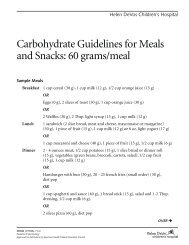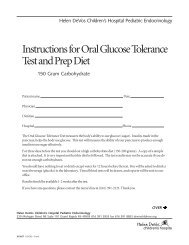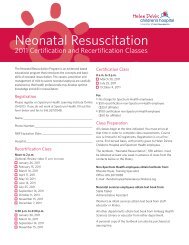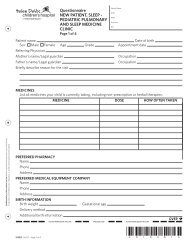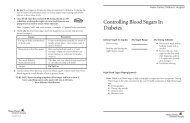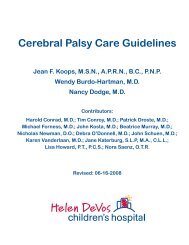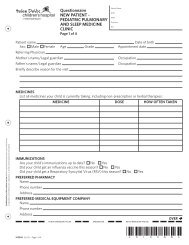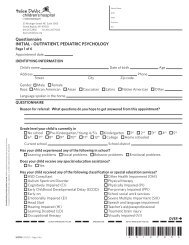High Frequency Vents with Neonatal & Pediatrics.pdf
High Frequency Vents with Neonatal & Pediatrics.pdf
High Frequency Vents with Neonatal & Pediatrics.pdf
Create successful ePaper yourself
Turn your PDF publications into a flip-book with our unique Google optimized e-Paper software.
Understand the principles ofHFJVUnderstand the clinicalapplications of HFJV
Delivery of small tidal volumes(V T ≤ V DS ) at supraphysiologicfrequencies
Adequate Gas ExchangeUsing Small Tidal Volumes• This possibility wasfirst illustrated as earlyas 1915• Henderson observedthe shallow breathingof panting dogs• Dogs could pantindefinitely <strong>with</strong>outbecoming hypoxic
Prevent Lung Injury in NICU Treat Lung Injury (Rescue)
Pressure Monitoring Line15-mm ConnectorJet Injection PortJet Port CapET Tube Connector
Exhalation• During HFJV, exhaledgas swirls outwardaround the incoming gas.• The exhaled gas sweepsthrough the CO 2 -richdeadspace gas.• This action may helpevacuate CO 2 andenhance ventilation.
pressure = 0+The highestpressure in the lungduring expiration isin the alveoli+ ++++Pressure drops asgas flows out theairways+++++
CHOKE POINTS may develop when:• airways lack structuralstrength• inadequate PEEP• during exhalation
• The high pressure in the alveoli canoverwhelm the airway walls whichencase gas at lower pressure++ +++ ++++
• Back pressure (<strong>High</strong> PEEP/Paw)may splint open the airway andallow gas to exitPEEP+ ++ ++
The Role of theConventional Ventilator• The Conventional Ventilator, whenoperated in tandem <strong>with</strong> the Jet,has 3 functions:1. Provide fresh gas for a patient’sspontaneous breathing2. Provide background IMVbreaths to open collapsedalveoliPEEP3. Regulate PEEP to maintainalveolar recruitment
Minimizing The Risks ofConventional Ventilation The support from the CV is most closely associated <strong>with</strong>barotrauma and volutrauma. Minimize these factors by running the conventionalventilator at minimal rates (i.e., from 1 to 3 BPM) andmoderate T I ’s. Using the conventional ventilator to gradually recruitcollapsed alveoli allows the Jet to achieve the bestpossible blood gases <strong>with</strong> the lowest possible airwaypressures.
RecruitmentStabilizationProtectionGet alveoli openKeep them openVentilate as gently as possible
RecruitmentStabilizationRaise PEEP & use low rate CMVtemporarily to open alveoliIncrease PEEP (Mean AirwayPressure) as needed for SaO 2ProtectionEliminate all CMV breaths; useHFJV – Most Gentle Ventilation
CMV “Sigh” breaths can be helpful<strong>with</strong> alveolar recruitment, but CMV iscontraindicated in presence of air leaks!
Three Ventilators, Same Blood GasesTracheal Pressure, cm H 2 O2015105000.20.4Time0.60.8secondsPawHFOVCVHFJVBoros, Mammel, et al. Ped Pulm. 1989; 7:35-41
Non-Homogenous Lung Disorders:• RDS complicated by PIE, PTX, etc.• Meconium aspiration and otherpneumonias (excessive secretions)• BPD / Chronic Lung Disease in NICUs
PIE<strong>High</strong> airwayresistance limits Jetventilationof injured regions.<strong>High</strong> R awawRDSAtelectatic areas<strong>with</strong> more patentairways get moreJet ventilation.Low C LWith HFJV: less gas to PIE areas, more gas to RDS areas.
• HFJV leads to the resolution of PIE morefrequently than does CV.• HFJV results in more rapid improvement of PIEthan does CV.• HFJV provides better gas exchange at lowerairway pressures compared to CV.• HFJV does not increase the incidence ofimportant complications.• HFJV improves survival in babies <strong>with</strong> PIE.(Keszler M, Donn SM, Bucciarelli RL, et al., 1991)
Heterogeneous Lung Model
User’s Guide toOptimizing HFJV
When will you start HFJV?
HFJV provides lung protective ventilation,and works especially well:1. to prevent lung injury, especially in preemies2. to treat air leaks & other lung injuries3. to treat non-homogeneous lung disease4. to clear excessive airway secretions (MAS)5. when respiratory failure is accompanied byhemodynamic problems (PPHN, CDH, cardiacanomalies, during and after cardiac surgery)
Choose an HFJV rate to matchpatient size and condition.(~10x CMV rate)
The smaller and stiffer the lungs,the faster you can go.
Slowing Jet rate lengthens E-time, whichhelps- exhalation thru obstructed airways,- encourage spontaneous breathing,- hasten extubation.
HFJV Rate I : E600 bpm 1 : 4420 1 : 6360 1 : 7300 1 : 9240 1 : 12More time forspontaneousbreathing!
Preserve existing lung volume& oxygenation by not allowingMAP to fall at HFJV initiation.
PressureIMV (good for alveolar recruitment)HFJV = Gentle VentilationYou must raise PEEP to maintain MAPPEEP and for MAP Stabilization/Oxygenation.enable Stabilization/OxygenationTimeThis a general recommendation, even for air leaks,but if increased PEEP interferes <strong>with</strong> cardiac output,you may compromise <strong>with</strong> lower PEEP, IMV ~ 5 bpm.
Adjust HFJV PIP tomanage PaCO 2
Use CMV “sigh” breathsto find optimal PEEP.
LungVolumeHFJVCVRate 420 CPAPPIPPEEPI-time204.02004PaO 2 < 50time
HFJVCVRate 420 3PIPPEEPI-time204.0203042.0PEEP is too low!VTime
V LHFJVCVRate 420 6PIPPEEPI-time208.0202080.4<strong>High</strong>er PEEPenables recruitment!Time
PaO 2 = 500LungVolumeHFJVCVRate 420 CPAPPIP 20 0PEEP 8 8I-time .020time
Start Assume HFJV, you’re lower using CV CV rate <strong>with</strong> to 5, PEEP and = keep 5, MAP alveoli = 9: fromcollapsing by maintaining MAP <strong>with</strong> increased PEEP :VMaintain Then switch HFJV CV at = to 5 this CPAP bpmPEEP mode & adjust to level, test FiO weaning PEEP. 2 toDoes FiO If SaO stabilize 2 to SaO 2 maintain falls, 2SaO fall increasewhen 2targetat 90%.5IMV SaO PEEP 2 breaths until as necessary FiO 2 ~ CPAP? 30%.to keep SaO 2 stable<strong>with</strong> HFJV + CPAP.PEEPMAP5 7 8925P
Importance of PEEP(Rat Lung Video)://
• Any time SaO 2 drops whenyou lower CMV rate, MAP istoo low!• So, raise PEEP.• Don’t keep using CMV breathsunless cardiac output suffersat higher PEEP.
Monitor Servo Pressure,Pulse Oximetry, andTranscutaneous PCO 2Be patient!
Servo Pressure• Servo Pressure is the DrivingPressure for HFJV.• It is feedback controlled by Jet’smicro-processor to adjust gasflow, so monitored PIP = set PIP.
Servo Pressure = driving pressure that provides Flow.Servo pressure changes as lung volume changes.ServoPressureIncreasesVolume IncreasesVolume DecreasesServoPressureDecreasesServo pressure changes = early warning of patient changes.INCREASESImproved complianceand/or resistanceIncreased airleakTubing leaksDECREASESWorsened complianceand/or resistance (bronchospasm)Tension pneumothoraxPatient needs suctioning
Servo Pressure• Feedback-Controlled Flow• Adjusts to maintain monitored pressure at setvalue• Increases for bigger and more compliant spaces• Decreased for smaller and less compliant spaces
The A bigger certain the amount space, of the flow more is required the flow torequired reach to a certain reach the amount same of pressure.in acertain amount of space.SpaceFlow requiredto reachPressure
The SMALLER the space, the LESS the flowrequired to reach the same pressure.SpaceFlow requiredto reachPressure
The bigger or more compliant the lungs, thehigher the Servo PressureBabyServo
The smaller or less compliant the lungs, thelower the Servo PressureBabyServo
The Importance of Servo PressureEffective Improving Clinical Compliance Tool or Bigger PatientPIP DropsServo Target Rises PIPtoPush PIP toTarget ValueBabyPIPServo
The Importance of Servo PressureWorsening Compliance or Smaller PatientBabyPIPServo
The Importance of Servo PressureTension PneumothoraxBabyPIPServo
The Importance of Servo PressureRight-Mainstem IntubationBabyPIPServo
The Importance of Servo PressureCorrecting a Right-Mainstem IntubationBabyPIPServo
Servo Pressure can alert you tochanges in the baby.
Wean to nasal CPAP
1. Wean big breaths first.(Get CV into CPAP mode.)2. Wean FiO 2 before PEEP/MAP.
1. Reduce HFJV PIP.2. Reducing HFJV Rate alsoworks, and it encouragesspontaneous breathing.
Patient is breathing spontaneously.HFJV PIP < 15, PEEP < 8, FiO 2 < 0.3P2015Set Nasal CPAP = HFJV MAPcm H 2 O1050.0 0.5 1.0Time, seconds1.52.0
• <strong>High</strong>ly Efficient, Very Gentle• <strong>High</strong> velocity inhalations enhanceflow streaming & healing of PIE,BPD, other lung injuries.• Passive, long exhalations enhancemucociliary clearance, pulmonaryperfusion, encourage spontaneousbreathing.



